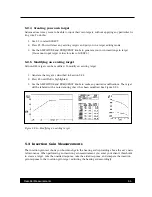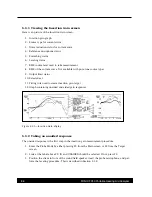
Automated Test Sequences
71
2. If you have chosen DSPA or DSPI in step 1, select the length of time each speech curve will
be presented with F3.
3. Select the type of equivalent input noise measurement taken with F5. The HFA/SPA/IEC
selections use a three frequency average to obtain the EIN. RMS uses a root-mean-square
average to take the measurement.
4. Choose the amount of noise reduction used in the soft speech curve with F6.
5. Choose the battery type with F7.
4.6.2 Running the test sequence
1. Level the sound chamber if necessary. See Section 3.2 for details.
2. Set the aid to normal user settings. If the aid has a volume control, it should be set to the set-
ting most used by the client.
3. Attach the aid to the appropriate coupler and place it in the sound chamber.
4. Close the door of the sound chamber.
5. Press START/STOP to begin the measurement.
6. After taking most of the measurements, the analyzer will pause. If the aid has a volume
control, use it to turn the aid to full-on gain and press START/STOP to complete the test.
Otherwise, press the DATA/GRAPH button to end the test.
4.6.3 Viewing the results
See Figure 4.6.3 for an example of a Profiler test sequence.
1. OSPL90: Pure-tone sweep at 90 dB SPL
2. Total harmonic distortion measurements
3. MAX OUT: Maximum output from the OSPL90 measurement
4. NOISE RED: Noise reduction used for soft measurement curve
5. CRV GAIN: RMS of the medium speech curve or overall average gain of the aid
6. EQ INP NOISE: Equivalent input noise and the type of measurement used to take it
7. BATTERY: Battery current drain
8. S, M, and L: Soft, medium, and loud speech curves taken at 50, 65, and 80 db SPL respec-
tively
9. R: Full-on gain response curve taken at 65 dB SPL
















































